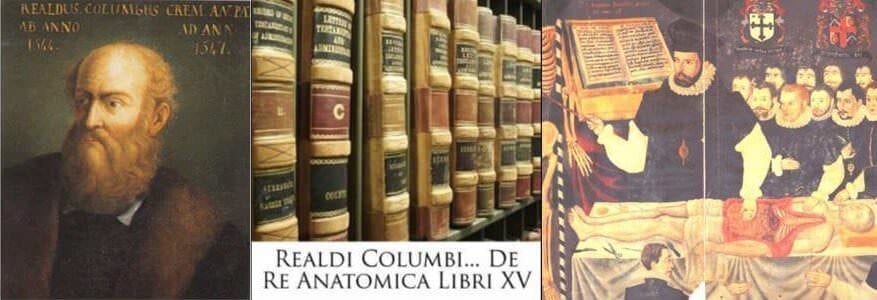
Although Italy during the Renaissance consisted of a mosaic of independent states, its inhabitants and particularly academicians seem to have moved freely from one city state to another. Thus it came about that the anatomist Matteo Realdo Colombo was born and educated in the principality of Milan (in philosophy and later as an apothecary); was apprenticed for seven years to a surgeon in Venice; and in 1538 moved to Padua to study anatomy and medicine. He was primarily an anatomist, but his observations on the heart and pulmonary circulation have earned him a special place in the history of cardiology.
Colombo remained in Padua from 1538 to 1545. He seems to have studied under Vesalius and later became his assistant, replacing him when he went to Basle to supervise the printing of his monumental De humani corporis fabrica. In 1543 the two had a public disagreement when Colombo criticized Vesalius over his interpretation of Galen. After the death of Vesalius in 1544 he succeeded him as professor at the University of Padua.
In his anatomical studies Colombo relied on dissection and also on vivisection. He described and named the placenta and was first to propose a role for the clitoris in female sexuality. In 1545 he was recruited by Cosimo di Medici of the Grand Duchy of Tuscany to teach anatomy at the University of Pisa; and in 1548 he moved to Rome and became personal surgeon to Pope Julius III, teaching anatomy at the Sapienza papal university and conducting anatomy demonstrations often attended by hundreds of people, including cardinals, archbishops, and other high ranking officials. He was a good friend of Pope Paul III; performed the autopsy on the body of St. Ignatius of Loyola; and collaborated with Michelangelo on a project of having him illustrate a medical anatomy text as well as being his doctor. After 1549 he treated Michelangelo for kidney stones and gouty arthritis, and it is possible that the later had uric acid stones and later obstructive uropathy.
His greatly influential book, De Re Anatomica, was published posthumously in 1559. Translated into English in 1578 and German in 1609, it became a standard textbook of anatomy. It consisted of fifteen chapters: on bones, cartilages, ligaments, and muscles (1-5), liver and veins (6); brain and nerves (8), glands (9), eyes (10), viscera (11), formation of the fetus (12), skin (13), vivisection (14), and “things rarely seen in anatomy” (15). Like his contemporary Michael Servetus, of whose writings he probably was unaware, Columbo described the blood in terms of regions (spirits or rivers), namely liver, heart, and brain, of which the latter was the chief member, being the source of all movement and sensation.
In chapter seven of his book Colombo discussed the heart and pulmonary circulation. Like Galen, he believed that the liver was the center of the circulatory system and that from the liver nutritive blood was sent to all parts of the body through the venous system. He denied the existence of pores in the intraventricular septum to allow blood to pass from the right side of the heart to the left, and expressed surprise that for so many years anatomist had thought that just because Galen had said so. Instead he explained that “the blood is carried through the pulmonary artery to the lung and there attenuated; then it is carried, along with air, through the pulmonary vein to the left ventricle of the heart,” a fact which he said “no one has noticed it or left it in writing.” Elsewhere in that chapter he described how cardiac valves prevented backflow of blood and how the heart propelled the blood by contraction, not dilatation:
Therefore when [the heart} is dilated . . . it receives blood from the vena cava into the right ventricle, and also prepared blood from the pulmonary vein . . . along with air into the left ventricle. And when the heart is compressed these valves are closed lest the vessels receive anything regressing along the same path; and at the same time the valves of both the aorta and pulmonary artery are opened; they permit the passage of the outgoing spirituous blood which is diffused through the whole body; and it is always thus when the heart is dilated that the other valves open and then shut . . . so that the blood which has entered the right ventricle is unable to return to the vena cava.
These observations of Colombo, like those of his compatriots Michael Servetus and Andrea Cesalpino, fell short of postulating a complete circulation of the blood, but paved the way to its recognition by William Harvey only a few decades later.

Leave a Reply